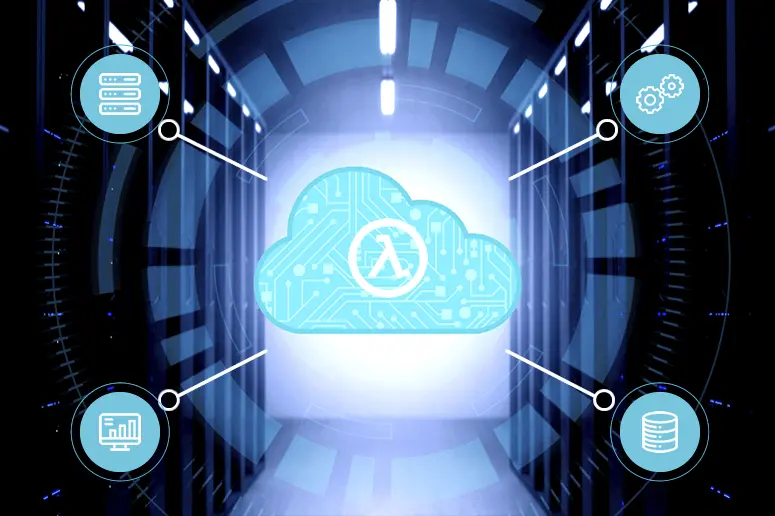Serverless Computing with AWS Lambda: Simplifying Application Development

Are you tired of managing servers and dealing with the complexities of infrastructure while trying to focus on building your dream applications? Do you find yourself struggling to keep up with ever-changing technology, server maintenance, and scaling challenges? If you answered “yes” to any of these questions, fear not! We have the perfect solution for you – AWS Lambda: the magic wand that simplifies application development and makes server management disappear!
In this blog, we will delve into the fascinating world of serverless computing with AWS Lambda. Say goodbye to the traditional server-based headaches, and say hello to a revolutionary approach that empowers you to write code without worrying about servers or infrastructure. With AWS Lambda, you can harness the power of event-driven architecture and unleash the potential of microservices, all while paying only for the compute time you use. Get ready to embark on a journey where application development becomes a breeze and your creativity knows no bounds.
Whether you’re a seasoned developer looking to simplify your workflows or an aspiring tech enthusiast curious about the future of application development, this blog has something magical in store for you. Let’s get started!
What is Serverless Computing?
Serverless computing is a cloud computing model that simplifies application development by abstracting away the complexity of managing servers and infrastructure. In this model, developers can focus solely on writing code for specific functions or tasks, while the cloud provider takes care of all the underlying server management. This approach allows developers to be more productive and efficient, as they don’t need to worry about server setup, scaling, or maintenance.
How Serverless Computing Works?
In serverless computing, developers create small, independent functions that perform specific tasks. These functions are sometimes referred to as “serverless functions” or “Lambda functions” in platforms like AWS Lambda. Each function can be triggered by specific events, such as a user request, changes to data, or a scheduled task. When an event occurs, the cloud provider automatically runs the corresponding function in response to that event.
Introducing AWS Lambda:
AWS Lambda is a serverless computing service provided by Amazon Web Services. It allows developers to execute code in response to various AWS events, such as changes to data in an Amazon S3 bucket, updates to a DynamoDB table, or incoming HTTP requests via Amazon API Gateway. AWS Lambda supports multiple programming languages, including Python, Node.js, Java, Go, and more, making it versatile and accessible to a wide range of developers.
Key Features of AWS Lambda
Event-Driven Execution: AWS Lambda functions are triggered in response to specific events. These events can be changes to data in an Amazon S3 bucket, updates to a DynamoDB table, HTTP requests via Amazon API Gateway, or various other AWS services. This event-driven approach enables real-time and near-real-time processing of data and events.
Auto-Scaling: AWS Lambda automatically scales the number of function instances based on the incoming workload. It ensures that there are enough instances available to handle concurrent events, and as the load decreases, it automatically scales down to save costs. This automatic scaling ensures applications can handle varying workloads efficiently.
Pay-Per-Use Pricing: One of the significant advantages of serverless computing is the pay-as-you-go billing model. With AWS Lambda, you only pay for the compute time consumed by your code. You are not charged when the code is idle, making it a cost-effective solution, especially for applications with unpredictable or intermittent workloads.
Support for Multiple Programming Languages: AWS Lambda supports a variety of programming languages, including Python, Node.js, Java, Go, and more. This makes it accessible to a wide range of developers, allowing them to write functions in their preferred language.
Integrated Security: AWS Lambda offers built-in security features, such as IAM roles and policies, to control access to resources and actions. Developers can set up fine-grained permissions to restrict access to specific AWS resources, ensuring the security of their applications.
High Availability: AWS Lambda is designed for high availability, with built-in redundancy across multiple Availability Zones (AZs) within a region. This ensures that your functions continue to run smoothly even in the case of hardware failures or other disruptions.
Simplifying Application Development with AWS Lambda

Faster Time-to-Market: Using AWS Lambda for application development significantly reduces the time it takes to deploy and scale applications. Developers can focus solely on writing code and implementing business logic without the need to manage servers, OS updates, or infrastructure scaling. This leads to quicker development cycles and faster time-to-market for new features and applications.
Seamless Integration with Other AWS Services: AWS Lambda easily integrates with various AWS services, creating a robust ecosystem for building complex and sophisticated applications. For instance, you can combine Lambda with Amazon S3 for serverless data processing, with Amazon API Gateway to create serverless APIs, or with Amazon DynamoDB for scalable, fully managed NoSQL databases.
Event-driven Microservices: Serverless computing, especially with AWS Lambda, promotes the microservices architectural pattern. Developers can break down large monolithic applications into smaller, manageable functions that perform specific tasks. These functions can be independently deployed, updated, and scaled, allowing for more flexible and maintainable applications.
Cost Optimization: With traditional server-based architectures, you have to pay for server resources, regardless of whether the code is actively processing requests or sitting idle. However, AWS Lambda’s pay-per-use pricing model ensures you only pay for the actual compute time your code consumes. This cost optimization is particularly beneficial for applications with varying workloads or those that experience intermittent traffic.
Server Management Made Easy: In traditional application development, managing servers and infrastructure can be a time-consuming and challenging task. Developers need to handle server setup, configuration, scaling, and maintenance, which can distract them from focusing on the core logic of their applications. With AWS Lambda, developers can bypass all of these server-related complexities. They can write their code, known as Lambda functions, and leave the server management entirely to AWS. This shift empowers developers to be more productive and efficient, as they no longer need to be concerned about server setup or maintenance.
Use Cases for AWS Lambda
AWS Lambda, with its serverless computing capabilities, is a versatile service that caters to various use cases across different industries. Let’s explore some of the common use cases where AWS Lambda excels:
1. Real-Time Data Processing: AWS Lambda is well-suited for processing real-time data streams, such as clickstreams, logs, or sensor data. By reacting to events as they happen, Lambda enables immediate data analysis and downstream actions based on the processed data. This is particularly useful in applications that require real-time insights and quick decision-making.
2. Serverless APIs: Developers can create fully managed, scalable APIs using AWS Lambda in conjunction with Amazon API Gateway. This combination allows for streamlined API development without the need to manage servers. Serverless APIs are cost-effective, easy to maintain, and can handle varying workloads efficiently.
3. Batch Processing: AWS Lambda is a great choice for batch processing tasks that require periodic or one-time data processing. Developers can configure events based on file uploads to Amazon S3, which trigger Lambda functions to automatically process the uploaded data. This can be used for tasks like image resizing, data transformations, and data cleansing.
4. Internet of Things (IoT) Applications: In the realm of IoT, AWS Lambda serves as an excellent backend for processing data generated by numerous IoT devices. The event-driven nature of Lambda allows it to handle real-time data streams from sensors, devices, and wearables. This enables real-time analytics and enables responsive actions based on IoT data.
5. Data ETL (Extract, Transform, Load): AWS Lambda can be integrated with other AWS services like Amazon S3, Amazon DynamoDB, or Amazon Redshift to perform data extraction, transformation, and loading operations. Developers can build scalable and cost-effective ETL pipelines that automatically process and move data between different storage systems.
6. Chatbots and Voice Assistants: AWS Lambda is widely used to power chatbots and voice assistants, like those integrated with Amazon Alexa or other platforms. The Lambda functions handle natural language processing, intent recognition, and provide responses based on user interactions, enabling interactive and conversational experiences.
7. Image and Video Analysis: With AWS Lambda, developers can build applications for image and video analysis, including object recognition, sentiment analysis, or facial recognition. By coupling Lambda with AWS services like Amazon Rekognition, developers can create powerful and intelligent applications without managing complex infrastructure.
8. Serverless Web Applications: AWS Lambda can be utilized to build the backend for serverless web applications. Developers can use Lambda functions to handle user authentication, process form submissions, manage databases, and interact with other AWS services, all without provisioning or managing servers.
Best Practices for Using AWS Lambda
AWS Lambda, as a serverless computing service, offers great flexibility and power, but to make the most of it, it’s essential to follow some best practices. Here are some key guidelines for using AWS Lambda effectively:
1. Optimize Function Runtime: Keep your Lambda functions as efficient as possible. Optimize the code to reduce execution time, and be mindful of external dependencies that might slow down the function. Using lightweight libraries and minimizing I/O operations can help improve performance.
2. Implement Error Handling: Handle errors effectively in your Lambda functions. Proper exception handling and logging mechanisms are crucial to identify and address issues quickly. AWS CloudWatch logs can be utilized to monitor and troubleshoot errors in Lambda functions.
3. Set Up Proper IAM Permissions: Use AWS Identity and Access Management (IAM) to manage permissions for Lambda functions. Follow the principle of least privilege and grant only the necessary permissions to your functions. Avoid using overly permissive IAM roles, as they can pose security risks.
4. Monitor Function Performance: Leverage AWS CloudWatch metrics to monitor the usage and performance of your Lambda functions. Monitoring metrics like invocation count, latency, and error rates can provide valuable insights into function behavior and performance.
5. Provisioned Concurrency for Frequent Invocations: If your Lambda functions experience frequent invocations and require low-latency responses, consider using Provisioned Concurrency. This feature keeps a certain number of function instances warm and ready to respond instantly, reducing cold start times.
6. Use Environment Variables: Avoid hardcoding configuration values in your Lambda functions. Instead, use environment variables to store configuration information, allowing you to change settings without modifying the code.
7. Enable Concurrent Executions: Make sure your Lambda functions can handle concurrent executions properly. Be mindful of shared resources and ensure that your functions are stateless and can run independently without conflicts.
8. Optimize Memory Allocation: Memory allocation affects the performance and cost of Lambda functions. Experiment with different memory settings to find the optimal balance between performance and cost efficiency. Remember that more memory may lead to faster execution times.
9. Consider Dead-Letter Queues: When using AWS Lambda with event sources like Amazon SQS or Amazon SNS, consider using dead-letter queues to capture failed events. This helps in analyzing and troubleshooting errors and ensures that failed events are not lost.
10. Version and Alias Management: Create versions and aliases for your Lambda functions to manage updates and rollbacks effectively. Versions allow you to keep track of changes, while aliases enable you to deploy new versions without changing the function’s invocation URLs.
11. Test Thoroughly: Perform thorough testing of your Lambda functions before deploying them to production. Use AWS SAM (Serverless Application Model) or local development environments to simulate Lambda function invocations and verify their behavior.
Wrapping it Up
AWS Lambda has transformed the way developers build and deploy applications by offering a serverless computing environment. By abstracting away infrastructure management and enabling event-driven architectures, Lambda simplifies application development and reduces time-to-market. Its seamless integration with other AWS services, pay-per-use pricing model, and scalability make it an attractive choice for a wide range of use cases. By following best practices and leveraging Lambda’s capabilities effectively, developers can unlock the full potential of serverless computing to build robust, cost-efficient, and scalable applications on the AWS platform.
Want more information about our services?
Similar Posts

A Comprehensive Guide to Embedded Software Development for Businesses
In an increasingly interconnected world, businesses across various industries rely on embedded systems to power their products and services. Embedded software development is a specialized field that creates software solutions tailored for these systems. In this comprehensive guide, we will explore what embedded software development entails, highlight the reasons for businesses to invest in it, […]...

Ultimate Guide To Pick A Software Development Outsourcing Partner in 2023
The process of selecting a reliable outsourcing partner for software development is complex and time-consuming. You may need a few months to do your due diligence and narrow down your options to a single service provider with whom you feel comfortable making a long-term commitment....

PHP vs .NET: An Exhaustive Comparison Between Two Popular Options for Web Developers
Not many people know that the full form of PHP is personal home page, which suggests that it was developed to create small applications. On the other hand, ASP.NET development services is a microsoft based technology and ideally used by organisations to build internal application. If you are someone who is is a dilemma of […]...









